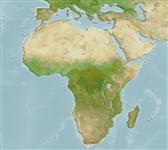Common names from other countries
Classification / Names / Names
Namen | Synonyme | Catalog of Fishes (gen., sp.) | ITIS | CoL | WoRMS
Environment: milieu / climate zone / depth range / distribution range
Ökologie
; tiefenbereich 20 - 40 m (Ref. 122059). Subtropical; 34°S - 33°S, 18°E - 27°E (Ref. 4)
Eastern Atlantic: South Africa and UK.
Length at first maturity / Size / Gewicht / Alter
Maturity: Lm ? range ? - ? cm Max length : 12.9 cm TL Männchen/unbestimmt; (Ref. 122061); 9 cm TL (female); common length : 10.0 cm TL Männchen/unbestimmt; (Ref. 4)
It has a total body length of 8 to 10 cm; and a carapace length of 4 to 5 cm (Ref. 4). Occurs at shallow coastal waters, rock pools (Ref. 4).
Life cycle and mating behavior
Geschlechtsreife | Fortpflanzung | Ablaichen | Eier | Fecundity | Larven
Members of the order Decapoda are mostly gonochoric. Mating behavior: Precopulatory courtship ritual is common (through olfactory and tactile cues); usually indirect sperm transfer.
Holthuis, L.B. 1991. (Ref. 4)
IUCN Rote Liste Status (Ref. 130435)
CITES Status (Ref. 108899)
Not Evaluated
Not Evaluated
Nutzung durch Menschen
Fischereien: nicht kommerziell
| FishSource |
Tools
Mehr Information
Alter/GrößeWachstumLänge-GewichtLänge-LängeMorphologieLarvenDichte
Internet Quellen
Estimates based on models
Preiskategorie
Unknown.
